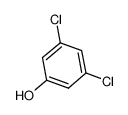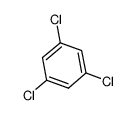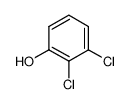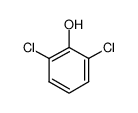1.Identification
1.1 GHS Product identifier
| Product name | 3,5-Dichlorophenol |
|---|
1.2 Other means of identification
| Product number | - |
|---|---|
| Other names | 3,5-Dichlor-phenol |
1.3 Recommended use of the chemical and restrictions on use
| Identified uses | For industry use only. |
|---|---|
| Uses advised against | no data available |
1.4 Supplier's details
| Company | MOLBASE (Shanghai) Biotechnology Co., Ltd. |
|---|---|
| Address | Floor 4 & 5, Building 12, No. 1001 North Qinzhou Road, Xuhui District, Shanghai, China |
| Telephone | +86(21)64956998 |
| Fax | +86(21)54365166 |
1.5 Emergency phone number
| Emergency phone number | +86-400-6021-666 |
|---|---|
| Service hours | Monday to Friday, 9am-5pm (Standard time zone: UTC/GMT +8 hours). |
2.Hazard identification
2.1 Classification of the substance or mixture
Acute toxicity - Oral, Category 4
Acute toxicity - Dermal, Category 3
Skin corrosion, Category 1B
Hazardous to the aquatic environment, long-term (Chronic) - Category Chronic 2
2.2 GHS label elements, including precautionary statements
| Pictogram(s) |    |
|---|---|
| Signal word | Danger |
| Hazard statement(s) | H302 Harmful if swallowed H311 Toxic in contact with skin H314 Causes severe skin burns and eye damage H411 Toxic to aquatic life with long lasting effects |
| Precautionary statement(s) | |
| Prevention | P264 Wash ... thoroughly after handling. P270 Do not eat, drink or smoke when using this product. P280 Wear protective gloves/protective clothing/eye protection/face protection. P260 Do not breathe dust/fume/gas/mist/vapours/spray. P273 Avoid release to the environment. |
| Response | P301+P312 IF SWALLOWED: Call a POISON CENTER/doctor/…if you feel unwell. P330 Rinse mouth. P302+P352 IF ON SKIN: Wash with plenty of water/... P312 Call a POISON CENTER/doctor/…if you feel unwell. P321 Specific treatment (see ... on this label). P361+P364 Take off immediately all contaminated clothing and wash it before reuse. P301+P330+P331 IF SWALLOWED: Rinse mouth. Do NOT induce vomiting. P303+P361+P353 IF ON SKIN (or hair): Take off immediately all contaminated clothing. Rinse skin with water [or shower]. P363 Wash contaminated clothing before reuse. P304+P340 IF INHALED: Remove person to fresh air and keep comfortable for breathing. P310 Immediately call a POISON CENTER/doctor/… P305+P351+P338 IF IN EYES: Rinse cautiously with water for several minutes. Remove contact lenses, if present and easy to do. Continue rinsing. P391 Collect spillage. |
| Storage | P405 Store locked up. |
| Disposal | P501 Dispose of contents/container to ... |
2.3 Other hazards which do not result in classification
none
3.Composition/information on ingredients
3.1 Substances
| Chemical name | Common names and synonyms | CAS number | EC number | Concentration |
|---|---|---|---|---|
| 3,5-Dichlorophenol | 3,5-Dichlorophenol | 591-35-5 | none | 100% |
4.First-aid measures
4.1 Description of necessary first-aid measures
General advice
Consult a physician. Show this safety data sheet to the doctor in attendance.
If inhaled
Fresh air, rest. Refer for medical attention.
In case of skin contact
Remove contaminated clothes. Rinse and then wash skin with water and soap. Refer for medical attention .
In case of eye contact
Rinse with plenty of water (remove contact lenses if easily possible). Refer for medical attention.
If swallowed
Rinse mouth. Rest. Refer for medical attention .
4.2 Most important symptoms/effects, acute and delayed
SYMPTOMS: Symptoms of exposure to this compound may include irritation of the skin, eyes, mucous membranes and upper respiratory tract. Prolonged contact can cause damage to the eyes, severe irritation and burns. Exposure to this class of compounds may cause profuse sweating, intense thirst, abdominal pain, nausea, vomiting, diarrhea, cyanosis from methemoglobinemia, hyperactivity, stupor, blood pressure fall, hyperpnea, hemolysis, convulsions, collapse, coma and pulmonary edema followed by pneumonia. If death from respiratory failure is not immediate, jaundice and oliguria or anuria may occur. Other symptoms of exposure to this class of compounds may include headache, dizziness, rapid and difficult breathing, weakness, severe burns and internal damage. Chronic exposure may result in digestive disturbances, nervous disorders, skin eruptions and liver and kidney damage. Skin contact with this type of compound may result in softening and whitening of the skin, followed by the development of painful burns. Prolonged contact may lead to dermatitis. Local contact may also result in painless blanching or erythema and corrosion of the skin. Skin sensitivity reactions occur occasionally. ACUTE/CHRONIC HAZARDS: This compound may be harmful by inhalation, ingestion or skin absorption. It is an irritant of the skin, eyes, mucous membranes and upper respiratory tract; and prolonged contact may result in severe irritation or burns. When heated to decomposition it emits toxic fumes of carbon monoxide, carbon dioxide and hydrogen chloride gas.
4.3 Indication of immediate medical attention and special treatment needed, if necessary
Immediate first aid: Ensure that adequate decontamination has been carried out. If patient is not breathing, start artificial respiration, preferably with a demand-valve resuscitator, bag-valve-mask device, or pocket mask, as trained. Perform CPR as necessary. Immediately flush contaminated eyes with gently flowing water. Do not induce vomiting. If vomiting occurs, lean patient forward or place on left side (head-down position, if possible) to maintain an open airway and prevent aspiration. Keep patient quiet and maintain normal body temperature. Obtain medical attention. /Phenols and related compounds/
5.Fire-fighting measures
5.1 Extinguishing media
Suitable extinguishing media
Extinguish fire using agent suitable for type of surrounding fire. Material itself does not burn or burns with difficulty. /Trichlorophenol/
5.2 Specific hazards arising from the chemical
Flash point data for this chemical are not available. It is probably combustible.
5.3 Special protective actions for fire-fighters
Wear self-contained breathing apparatus for firefighting if necessary.
6.Accidental release measures
6.1 Personal precautions, protective equipment and emergency procedures
Use personal protective equipment. Avoid dust formation. Avoid breathing vapours, mist or gas. Ensure adequate ventilation. Evacuate personnel to safe areas. Avoid breathing dust. For personal protection see section 8.
6.2 Environmental precautions
Personal protection: chemical protection suit including self-contained breathing apparatus. Do NOT let this chemical enter the environment. Sweep spilled substance into covered containers. If appropriate, moisten first to prevent dusting. Carefully collect remainder. Then store and dispose of according to local regulations.
6.3 Methods and materials for containment and cleaning up
Land Spill: Dig a pit, pond, lagoon, or holding area /SRP: If time permits, pits, ponds, lagoons, soak holes, or holding areas should be sealed with an impermeable flexible membrane liner./to contain liquid or solid material. Cover solids with plastic sheet to prevent dissolving in rain or fire fighting water. /Trichlorophenol/
7.Handling and storage
7.1 Precautions for safe handling
Avoid contact with skin and eyes. Avoid formation of dust and aerosols. Avoid exposure - obtain special instructions before use.Provide appropriate exhaust ventilation at places where dust is formed. For precautions see section 2.2.
7.2 Conditions for safe storage, including any incompatibilities
Store only in original container. Store in an area without drain or sewer access. Provision to contain effluent from fire extinguishing. Separated from oxidants and food and feedstuffs. Ventilation along the floor.
8.Exposure controls/personal protection
8.1 Control parameters
Occupational Exposure limit values
no data available
Biological limit values
no data available
8.2 Appropriate engineering controls
Handle in accordance with good industrial hygiene and safety practice. Wash hands before breaks and at the end of workday.
8.3 Individual protection measures, such as personal protective equipment (PPE)
Eye/face protection
Safety glasses with side-shields conforming to EN166. Use equipment for eye protection tested and approved under appropriate government standards such as NIOSH (US) or EN 166(EU).
Skin protection
Wear impervious clothing. The type of protective equipment must be selected according to the concentration and amount of the dangerous substance at the specific workplace. Handle with gloves. Gloves must be inspected prior to use. Use proper glove removal technique(without touching glove's outer surface) to avoid skin contact with this product. Dispose of contaminated gloves after use in accordance with applicable laws and good laboratory practices. Wash and dry hands. The selected protective gloves have to satisfy the specifications of EU Directive 89/686/EEC and the standard EN 374 derived from it.
Respiratory protection
Wear dust mask when handling large quantities.
Thermal hazards
no data available
9.Physical and chemical properties
| Physical state | yellow to light brown crystals, crystalline powder |
|---|---|
| Colour | Prisms from petroleum ether |
| Odour | no data available |
| Melting point/ freezing point | 177°C(lit.) |
| Boiling point or initial boiling point and boiling range | 122°C/8mmHg(lit.) |
| Flammability | Combustible. Gives off irritating or toxic fumes (or gases) in a fire. |
| Lower and upper explosion limit / flammability limit | no data available |
| Flash point | 121°C(lit.) |
| Auto-ignition temperature | no data available |
| Decomposition temperature | no data available |
| pH | no data available |
| Kinematic viscosity | no data available |
| Solubility | less than 1 mg/mL at 20°C |
| Partition coefficient n-octanol/water (log value) | log Kow = 3.62 |
| Vapour pressure | 0.00842 mm Hg at 25°C |
| Density and/or relative density | 1.458 g/cm3 |
| Relative vapour density | (air = 1): 5.6 |
| Particle characteristics | no data available |
10.Stability and reactivity
10.1 Reactivity
no data available
10.2 Chemical stability
Stable under recommended storage conditions.
10.3 Possibility of hazardous reactions
3,5-DICHLOROPHENOL is incompatible with acid chlorides, acid anhydrides and oxidizing agents.
10.4 Conditions to avoid
no data available
10.5 Incompatible materials
no data available
10.6 Hazardous decomposition products
When heated to decomposition it emits toxic vapors of /hydrogen chloride/.
11.Toxicological information
Acute toxicity
- Oral: LD50 Mouse (male CD-1 ICR) oral 2643 mg/kg.
- Inhalation: no data available
- Dermal: no data available
Skin corrosion/irritation
no data available
Serious eye damage/irritation
no data available
Respiratory or skin sensitization
no data available
Germ cell mutagenicity
no data available
Carcinogenicity
no data available
Reproductive toxicity
no data available
STOT-single exposure
no data available
STOT-repeated exposure
no data available
Aspiration hazard
no data available
12.Ecological information
12.1 Toxicity
- Toxicity to fish: LC50; Species: Danio rerio (Zebra danio, length 2.5 cm); Conditions: freshwater, static, 22°C, pH 7.8-8, hardness 150 mg/L CaCO3; Concentration: 1000-3500 ug/L for 24 hr
- Toxicity to daphnia and other aquatic invertebrates: no data available
- Toxicity to algae: EC50; Species: Pseudokirchneriella subcapitata (Green algae, age 3 days, exponential growth phase); Conditions: freshwater, static, 23°C, flask bioassay, continuous white light and stirring; Concentration: 1790 ug/L for 72 hr (95% confidence interval: 1660-1920 ug/L); Effect: decreased population growth rate /100% purity
- Toxicity to microorganisms: no data available
12.2 Persistence and degradability
BACTERIAL TOXICITY LIMITS DETERMINED BY 5 METHODS AGREED WITH LIMITS FOUND IN DEGRADATION TESTS IN LAB ACTIVATED SLUDGE EQUIPMENT. IN BIODEGRADATION TESTS WITH INDUSTRIAL WASTEWATER, BACTERIA BECAME ADAPTED TO 3,5-DICHLOROPHENOL WITHIN A FEW WEEKS.
12.3 Bioaccumulative potential
A BCF range of 9 to 82 was measured in fish for 3,5-dichlorophenol using carp (Cyprinus carpio) which were exposed over a eight week period to a water concentration of 30 ppb, according to the standard test of the Japanese Ministry of Industry and Trade (MITI)(1). According to a classification scheme(2), this BCF suggests the potential for bioconcentration in aquatic organisms is moderate(SRC).
12.4 Mobility in soil
The Koc of 3,5-dichlorophenol is estimated as 1,200(SRC), using a log Kow of 3.62(1), and a regression-derived equation(2). According to a classification scheme(3), this estimated Koc value suggests that 3,5-dichlorophenol is expected to have low mobility in soil. The pKa of 3,5-dichlorophenol is 8.18(4), indicating that this compound will partially exist in anion form in the environment and anions generally do not adsorb more strongly to soils containing organic carbon and clay than their neutral counterparts(5).
12.5 Other adverse effects
no data available
13.Disposal considerations
13.1 Disposal methods
Product
The material can be disposed of by removal to a licensed chemical destruction plant or by controlled incineration with flue gas scrubbing. Do not contaminate water, foodstuffs, feed or seed by storage or disposal. Do not discharge to sewer systems.
Contaminated packaging
Containers can be triply rinsed (or equivalent) and offered for recycling or reconditioning. Alternatively, the packaging can be punctured to make it unusable for other purposes and then be disposed of in a sanitary landfill. Controlled incineration with flue gas scrubbing is possible for combustible packaging materials.
14.Transport information
14.1 UN Number
| ADR/RID: UN2020 | IMDG: UN2020 | IATA: UN2020 |
14.2 UN Proper Shipping Name
| ADR/RID: CHLOROPHENOLS, SOLID |
| IMDG: CHLOROPHENOLS, SOLID |
| IATA: CHLOROPHENOLS, SOLID |
14.3 Transport hazard class(es)
| ADR/RID: 6.1 | IMDG: 6.1 | IATA: 6.1 |
14.4 Packing group, if applicable
| ADR/RID: III | IMDG: III | IATA: III |
14.5 Environmental hazards
| ADR/RID: yes | IMDG: yes | IATA: yes |
14.6 Special precautions for user
no data available
14.7 Transport in bulk according to Annex II of MARPOL 73/78 and the IBC Code
no data available
15.Regulatory information
15.1 Safety, health and environmental regulations specific for the product in question
| Chemical name | Common names and synonyms | CAS number | EC number |
|---|---|---|---|
| 3,5-Dichlorophenol | 3,5-Dichlorophenol | 591-35-5 | none |
| European Inventory of Existing Commercial Chemical Substances (EINECS) | Listed. | ||
| EC Inventory | Listed. | ||
| United States Toxic Substances Control Act (TSCA) Inventory | Listed. | ||
| China Catalog of Hazardous chemicals 2015 | Not Listed. | ||
| New Zealand Inventory of Chemicals (NZIoC) | Listed. | ||
| Philippines Inventory of Chemicals and Chemical Substances (PICCS) | Not Listed. | ||
| Vietnam National Chemical Inventory | Not Listed. | ||
| Chinese Chemical Inventory of Existing Chemical Substances (China IECSC) | Not Listed. | ||
16.Other information
Information on revision
| Creation Date | Aug 12, 2017 |
|---|---|
| Revision Date | Aug 12, 2017 |
Abbreviations and acronyms
- CAS: Chemical Abstracts Service
- ADR: European Agreement concerning the International Carriage of Dangerous Goods by Road
- RID: Regulation concerning the International Carriage of Dangerous Goods by Rail
- IMDG: International Maritime Dangerous Goods
- IATA: International Air Transportation Association
- TWA: Time Weighted Average
- STEL: Short term exposure limit
- LC50: Lethal Concentration 50%
- LD50: Lethal Dose 50%
- EC50: Effective Concentration 50%
References
- IPCS - The International Chemical Safety Cards (ICSC), website: http://www.ilo.org/dyn/icsc/showcard.home
- HSDB - Hazardous Substances Data Bank, website: https://toxnet.nlm.nih.gov/newtoxnet/hsdb.htm
- IARC - International Agency for Research on Cancer, website: http://www.iarc.fr/
- eChemPortal - The Global Portal to Information on Chemical Substances by OECD, website: http://www.echemportal.org/echemportal/index?pageID=0&request_locale=en
- CAMEO Chemicals, website: http://cameochemicals.noaa.gov/search/simple
- ChemIDplus, website: http://chem.sis.nlm.nih.gov/chemidplus/chemidlite.jsp
- ERG - Emergency Response Guidebook by U.S. Department of Transportation, website: http://www.phmsa.dot.gov/hazmat/library/erg
- Germany GESTIS-database on hazard substance, website: http://www.dguv.de/ifa/gestis/gestis-stoffdatenbank/index-2.jsp
- ECHA - European Chemicals Agency, website: https://echa.europa.eu/

















![1338215-37-4 spectrum, [2-(3,5-dichlorophenoxy)ethyl]trimethylsilane](http://saasimg.molbase.net/mol_command/294fce371998422cb9b99e63125e7035.png)





